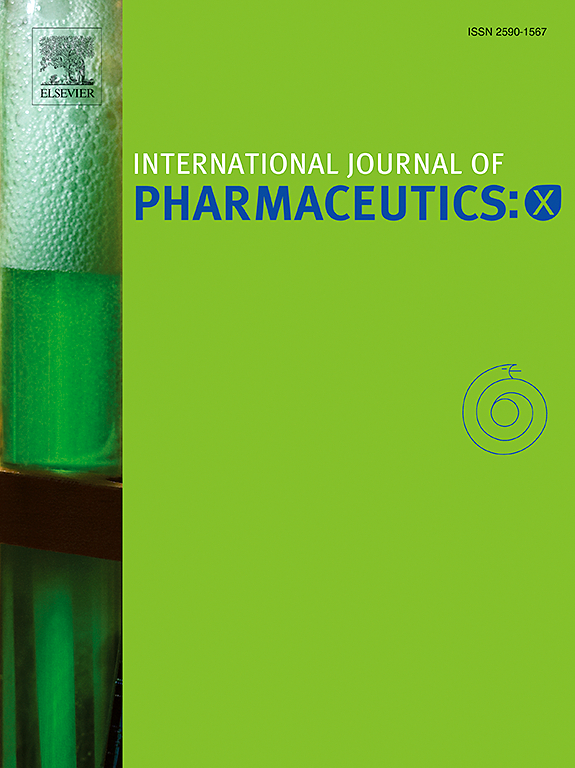体外表征、环糊精配合物的细胞毒性和细胞摄取以及与雷洛昔芬的功能赋形剂(壬二酸、酒石酸和精氨酸)的离子配对/盐形成
IF 6.4
2区 医学
Q1 PHARMACOLOGY & PHARMACY
引用次数: 0
摘要
随着药物再利用的进步,寻找有效且危害较小的抗癌药物仍然是一项关键的努力。雷洛昔芬虽然不是一种典型的抗癌药物,但在这种情况下还是有希望的。然而,其溶解度差对其治疗潜力和配方效率提出了重大挑战。研究了环糊精(如β-环糊精、羟基丙基β-环糊精和Captisol)和ph修饰辅料(如酒石酸、壬二酸和精氨酸)等功能性辅料通过二元固体分散体增强Caco-2细胞系的溶解度、溶出度、细胞毒性和细胞摄取。硅研究表明,雷洛昔芬-壬二酸和雷洛昔芬-酒石酸以及环糊精包合物可能形成盐。实验结果表明,ph修饰的赋形剂,特别是酒石酸和壬二酸,显著提高了溶解度(提高了800倍),优于环糊精(提高了8倍)。对人类乳腺癌细胞的细胞毒性研究(密歇根癌症基金会,MCF-7)表明,雷洛昔芬-酒石酸可显著增强细胞杀伤,其疗效可与标准抗癌药物紫杉醇媲美。此外,荧光标记的雷洛昔芬:羟基丙基β-环糊精共沉淀混合物(Coppt)和雷洛昔芬:酒石酸Coppt均表现出浓度和时间依赖性的细胞摄取,平均荧光强度在24小时显著增加,表明快速内化和持续的细胞内保留,特别是在较高浓度下。更有趣的是,优越的细胞摄取有利于后者,表明ph修饰赋形剂酒石酸,这些发现与溶解度和溶出度研究密切相关。本文章由计算机程序翻译,如有差异,请以英文原文为准。

Formulation, in silico, in vitro characterization, cytotoxicity and cellular uptake of cyclodextrin complexes and ion pairing/salt formation with functional excipients (azelaic acid, tartaric acid, and arginine) with raloxifene
With advancements in drug repurposing, the search for effective and less harmful anticancer agents remains a critical endeavor. Raloxifene, although not a typical anticancer drug, holds promise in this context. However, its poor solubility poses a significant challenge to its therapeutic potential and formulation efficiency. Functional excipients such as cyclodextrins (e.g., β-cyclodextrin, hydroxy propyl β-cyclodextrin, and Captisol) and pH-modifying excipients (e.g., tartaric acid, azelaic acid, and arginine) were investigated to enhance solubility, dissolution, cytotoxicity and cellular uptakes employing Caco-2 cell lines through binary solid dispersions. In silico studies suggested the potential for salt formation with raloxifene-azelaic acid and raloxifene-tartaric acid, as well as inclusion complexes with cyclodextrins. Experimental results showed that pH-modifying excipients, particularly tartaric and azelaic acids, significantly improved solubility (up to an 800-fold increase), outperforming cyclodextrins (8-fold increase) compared to the untreated drug. Cytotoxicity studies on the human breast cancer (Michigan cancer foundation, MCF-7) cells revealed that raloxifene-tartaric acid significantly enhanced cell killing, achieving efficacy comparable to the standard anticancer drug Taxol. Additionally, both fluorescence-labeled raloxifene: hydroxy propyl β-cyclodextrin coprecipitated mixtures (Coppt) and raloxifene: tartaric acid Coppt exhibited concentration- and time-dependent cellular uptake, with mean fluorescence intensity increasing significantly at 24 h, indicating rapid internalization and sustained intracellular retention, especially at higher concentrations. More interestingly, the superior cellular uptake was in favor of the latter, indicating the pH-modifying excipient tartaric acid, and these findings correlated well with solubility and dissolution studies.
求助全文
通过发布文献求助,成功后即可免费获取论文全文。
去求助
来源期刊

International Journal of Pharmaceutics: X
Pharmacology, Toxicology and Pharmaceutics-Pharmaceutical Science
CiteScore
6.60
自引率
0.00%
发文量
32
审稿时长
24 days
期刊介绍:
International Journal of Pharmaceutics: X offers authors with high-quality research who want to publish in a gold open access journal the opportunity to make their work immediately, permanently, and freely accessible.
International Journal of Pharmaceutics: X authors will pay an article publishing charge (APC), have a choice of license options, and retain copyright. Please check the APC here. The journal is indexed in SCOPUS, PUBMED, PMC and DOAJ.
The International Journal of Pharmaceutics is the second most cited journal in the "Pharmacy & Pharmacology" category out of 358 journals, being the true home for pharmaceutical scientists concerned with the physical, chemical and biological properties of devices and delivery systems for drugs, vaccines and biologicals, including their design, manufacture and evaluation. This includes evaluation of the properties of drugs, excipients such as surfactants and polymers and novel materials. The journal has special sections on pharmaceutical nanotechnology and personalized medicines, and publishes research papers, reviews, commentaries and letters to the editor as well as special issues.
 求助内容:
求助内容: 应助结果提醒方式:
应助结果提醒方式:


